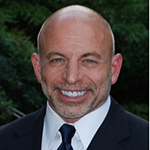By LISA EISENHAUER
May 18, 2020
When it comes to the spread of the COVID-19 virus, James Giordano said testing paired with high-tech surveillance tools could identify who is infected and who they might have exposed since they contracted the deadly virus and where upswing in infections is likely to occur.

Giordano
Those monitoring tools could potentially prevent the pandemic from becoming a worse scourge than it already is and help the nation get its economy back on track, he said.
With that awesome surveillance capability, however, comes equally important ethical and privacy considerations, said Giordano, a professor in the departments of neurology and biochemistry, and a senior scholar at the Pellegrino Center for Clinical Bioethics at Georgetown University.
Giordano urged that, before going any further into the surveillance realm to track the virus among individuals, the nation should pass and enact legislation that puts safeguards in place to make sure that the data collected isn't misused.
He shared his thoughts during a webinar May 14 titled "Pandemic Public Surveillance: Issues of Prevention, Protection, and Privacy." The webinar was the fifth in the series "Catholic Ethics and the challenge of COVID-19" that is being presented on consecutive Thursdays through May by CHA and Georgetown University with participation from the Pellegrino Center.
Continuing threat
In addition to his work at Georgetown, Giordano does work for the Department of Defense that focuses on biosecurity and biowarfare, including how pathogens spread, and he is consulting bioethicist for its Medical Ethics Committee, which is currently addressing ethical issues in biosecurity and biomedical responses to the COVID-19 crisis.
He said his research on the virus indicates that its spread could have started earlier and thus could be much wider than has been reported. He also said the virus might be taking multiple forms, which could explain the array of symptoms of the infection and, for some people, the lack of symptoms.
Giordano predicted the world has yet to see the worst of the pandemic, or even of its first wave. He said the current wave will likely hit its peak later this month or next followed by a rebound in the fall and perhaps a third surge next spring or summer.
He compared the crisis the pandemic is causing to the horns of a bull with public safety and health on one side and socioeconomic stability on the other. Critical to filing down those horns is "efficient, affordable and accessible testing."
Need for monitoring
Once that testing is in place and the public is categorized into those who are infected, those who have recovered and could potentially be immune and those who are still vulnerable to the virus, then resources could be allocated based on their needs, Giordano said, but to do that requires monitoring. That monitoring can take many forms from self-reporting to the use of mapping tools that can detect and record where an individual is at any given moment and biometric tools that can detect and record specific information about each person's physical health.
"It may very well be that we utilize these sort of black box big data methods to be able to develop patterns and then create patterns that are not only descriptive but are in many ways predictive," he said.
That data collection would open a Pandora's box in which there is the potential to suppress the spread of the virus and its many effects but also the potential for loss of privacy and personal liberties, Giordano said. Among the questions raised, he said, are: What do we do with the information and capability we have? Given what we can do, what should we do?
Benefits and burdens
Giordano said he and colleagues of his who have studied the pandemic and the scope of surveillance that could be used to contain it have concluded that civic institutions aren't ready to use the data that potentially could be collected "in a way that is both pragmatically sound, prudent and at the same time protective," he said.
"What we need before we go forward is something to be called a Medical Information Non-Discrimination Act," he added.
That national act, he said, would set up ethical and legal safeguards to protect the privacy of those being monitored. In addition, it would require "programmatic biosecurity" to ensure that the collections systems can't be hacked or corrupted.
Giordano said legislative privacy protections need to keep pace with surveillance technology.
"I ask you to pay attention to what's happening," he said. "I ask you to recognize that the benefits are certainly apparent but those benefits also incur, like so many other things, burdens and potential harms as well."
The webinar series continues at 1 p.m. Eastern time Thursday with a discussion on "The Role of Medical and Nursing Students in a Pandemic."
Prior coverage of this webinar series
Resuscitation considerations go beyond patients amid pandemic, Catholic ethicists say
Putting workers first for some treatments amid pandemic is justifiable, ethicists say
Crash course: Sully offers inspiration for applying organizational ethics in a pandemic
Constraints of pandemic care are potential triggers of moral distress, ethicists say
View the webinar recording